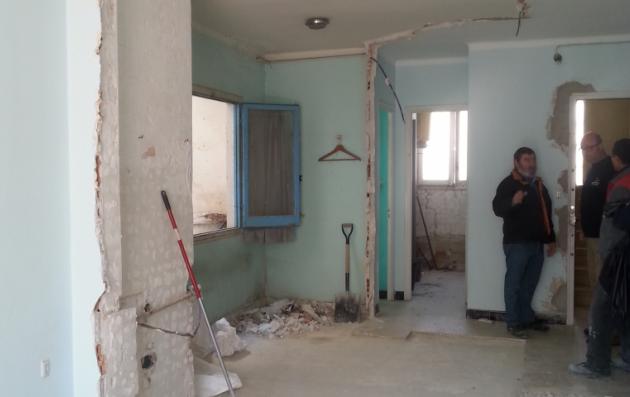Summary
In the context of high poverty, exclusion and the increasing number of empty housing units, accentuated by the crisis, the Vilafranca (ES) Inclusion programme deals with the renovation and rehabilitation of vacant housing while reusing them for social purposes.
Bringing together the municipality, social actors, NGOs and house owners, the programme is built on a multiannual approach. It uses the renovation process for occupational training and boosting employment among the people risking social exclusion or long-time poverty.
So far, more than 250 houses have been renovated and offered on preferential lease to poor or homeless families, and 500 persons have gained professional skills through the training programmes. The Vilafranca Inclusion practice has already been recognised by Un Habitat Europe and the Pi i Sunyer Foundation.
The solutions offered by the good practice
Rehabilitate vacant homes and reuse them with a social purpose
- Use the process of rehabilitation for occupational training and boosting employment of unemployed.
- Provide homes to families and / or people with a low income and on a situation of emergency residential risk.
- Improve housing park standards: prevent the progressive deterioration of buildings and parts of the city.
- Reduction of empty housing.
- Using housing as a tool for socio-educational work.
- Promote employability.
Building on the sustainable and integrated approach
Vilafranca Inclusion exemplifies the three pillars of the URBACT principles:
Horizontal integration: incorporates the cross-work of various municipal services for the analysis and implementation in different phases. Carried out in the period 2013/2015, it has a direct relation to the tasks performed at the C.R.I.T. (Resource Centre for Inclusion and Employment) aimed at people at risk of exclusion. It deals with the subjects of: urban planning, improving degraded areas of the city; environmental, upgrading homes to optimal levels of energy efficiency; new economies creation, area of housing rehabilitation, specialized training; promotion of cooperative economics, etc.
Vertical integration: its development involves promoters and beneficiaries. There are three lines of work in parallel:
A) Urban Planning: properties to be rehabilitated are evaluated, designed and valued. Also, private foundations, the Town Hall itself and financial institutions can provide housing to be included in the rehabilitation programme.
B) Social Services: selection of participants and the design of the employment plans.
C) Training and Employment: training options. From there begins the execution phase of the work, and training of participants is done through a company (cooperative) of social integration. Territorial integration: rehabilitating housing in degraded areas helps the greater integration of the whole town, reducing the risk of having marginal areas.
Based on a participatory approach
Among those involved has woven a network of co-operation. Whilst Caritas supports the training of the participants in the project, the insertion cooperative insert Nou Set does the contracts. Moreover, the Town Hall, through C.R.I.T. manages the program, partly funded by the Diputació de Barcelona. The partnership also extends to the active participation of property owners and end users. Apart from the three lines of action involved in the project (Social Services, Town Planning, and Training and Employment) parallel tasks of development are established.
What difference has it made?
The impact of Vilafranca Inclusion is multiple and has benefited its citizenship as a result of the change that occurred in the mechanics of the programme from 2012, when - as a result of the economic crisis - rehabilitation and social integration were put at the same level as axes. Since its implementation in 1992, it has allowed the family core to have a regular income, it has standardised the employment status of participating workers, has allowed us to train them in professional skills, and also, significantly, it has equipped them with the capacity to be able to find a job in the present circumstances of the labour market. Otherwise, participation has been opened to members of the family who are unemployed. The profile of participants and attended has changed in line with social changes experienced in the types of families: for example, in 2015, 84 families were assisted (a total of 243 people), of which 49% were single-parent families and 42% of users were under 16 years of age. 250 dwellings have been rehabilitated, of which the Town Hall still manages 90 through Social Housing. The rest - leased to the town council - have already been returned to their owners.
- People trained: approximately 500 (data from 1992)
- Families inserted: 50 since 2013.
Why should other European cities use it?
From its beginnings in 1992, the practice has been adapted to the current social context, characterised by the strong economic crisis that has forced many municipalities to adapt expenditures allocated to social issues. Vilafranca implemented "Vilafranca Inclusion" aiming to rehabilitate and reuse dwellings for social purposes. The 2012 programme is reoriented and focused on the social and labour inclusion of unemployed people and families at risk of exclusion. The impact of the practice is satisfactory and strengthens their impact on policy and management of the municipality. We believe that this course of action can be useful and interesting for any European city facing these issues.
-
390_Vilafranca_GPsummary.pdf(PDF, 130Ko)

